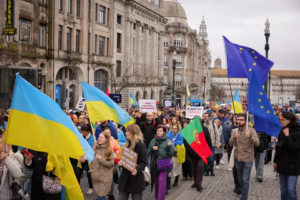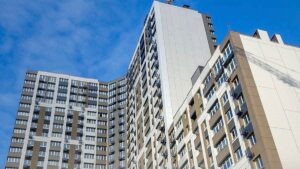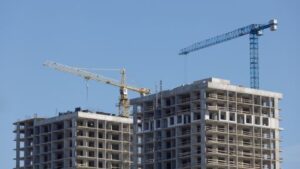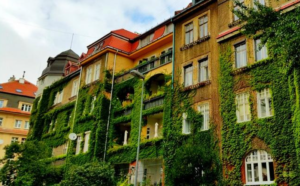
According to the Turkish Statistical Institute (TÜİK), in September 2025, sales of real estate to foreigners in Turkey fell by 7.7% year-on-year to 1,867 properties. The share of transactions with foreigners in the total volume was 1.2%. Most purchases were made in Istanbul (744), followed by Antalya (557) and Mersin (124).
Among foreign buyers, Russians took first place with 267 properties, followed by Iranians with 202 and Iraqis with 146. The top five also included citizens of Germany with 121 and Ukraine with 118. In January-September, foreigners purchased 14,944 properties, which is 12.6% less than a year earlier.
A total of 150,657 residential units were sold on the Turkish market in September, which is 6.9% more than in September 2024.

According to Eurostat, as of the end of July 2025 there are 4,373,455 citizens of Ukraine under temporary protection in EU countries. Over the month their number increased by 30,980 people, that is approximately by 0.71% compared to the June level — the dynamics are moderate but stable, indicating a continuing, though not surging, movement of people in search of safety. The overwhelming majority of beneficiaries of this regime — about 98.4% — are Ukrainians, which makes the group of aid recipients extremely homogeneous and requires focused integration measures.
The distribution by countries remains concentrated: the key burden is borne by Germany, Poland, and the Czech Republic. In Germany there are about 1,196,645 people — roughly 27.8% of the total; in Poland — about 992,505 people (around 23%); in the Czech Republic — about 378,420 people (about 8.8%). Taken together this is almost three-fifths of all recipients of protection, therefore it is precisely these economies and their social systems that first react to any changes in inflow: in large agglomerations the issues of housing affordability become acute, the need for school places and language courses grows, and municipal budgets face continuous obligations.
In such conditions, reception policy inevitably shifts to an integration agenda. Coming to the fore are the accelerated recognition of qualifications, intensive language programs, access to kindergartens and schools, as well as reskilling instruments. The labor market becomes the main shock absorber: the faster people move into formal employment, the lower the budgetary burden and the more noticeable the multiplier effect for domestic demand. At the same time, the housing issue remains the key risk: concentration in capital and industrial regions pushes rental rates upward and increases social tension. Effective responses appear to be targeted rent subsidies, accelerated renovation and construction of social housing, as well as a more even distribution of placements among municipalities.
Finally, the predictability of financing and interagency coordination at the EU and national government levels becomes critically important. Even with the current “soft” monthly increase, unreliable sources of funds quickly turn a manageable situation into a problem for local budgets. On the horizon of the coming months, the key indicators of resilience will be the growth rates of protection beneficiaries, the share of those employed, indicators of school and preschool integration, the dynamics of rental rates in concentration regions, and the speed of transition from emergency measures to long-term programs. Overall, the picture of stable but continuing growth with high concentration in Germany, Poland, and the Czech Republic requires shifting efforts from short-term aid to systemic integration — precisely this will make it possible to reduce budgetary costs and turn the humanitarian response into a sustainable socio-economic result.
EU, GERMANY, HOUSING, Labor market, MIGRATION, POLAND, REFUGEES, SOCIAL POLICY, TEMPORARY PROTECTION, UKRAINIANS

The rental market in Budapest (Hungary) in 2025 is experiencing price increases and increased competition, especially in the central areas of the capital, according to analysts and realtors.
According to Global Property Guide, the average asking rent for a one-bedroom apartment in Budapest in 2025 is around HUF 264,000 (≈ USD 713) per month.
Rental rates are rising: in January 2025, asking prices in Budapest rose by 1.8% compared to the previous month, with annual growth of around 9.5%.
For two-bedroom apartments, rental prices in central areas in 2024 ranged from €1,000 to €1,500 per month.
However, in central Budapest (districts 5, 6, 7, 1), the rent for a one-bedroom apartment can be €800–1,500, and in residential areas or outer districts, €600–850.
The share of households living in rented accommodation in Budapest has increased from 12.7% to 17.5% in recent years. The growth is particularly noticeable among young people: a significant proportion of the 20-35 age group rent their accommodation.
The gross rental yield (before expenses) in Hungary is around 5.06% (2025, Q3).
Demand for rentals is growing faster than new housing is being built, especially apartment buildings in central areas, creating a shortage and pushing rents up. In addition, the debate over the regulation of short-term rentals (Airbnb and similar) is intensifying: one district of Budapest has voted to ban short-term rentals starting in 2026, which could affect the overall rental market.
Source: http://relocation.com.ua/budapest-rental-housing-market-analysis-by-relocation/

The cost of housing construction since the beginning of 2025 has increased on average by 10-25% depending on the class of housing, the main factors of growth were the rise in the cost of construction materials and logistics, as well as the increase in wages in the industry, Ukrainian developers told the agency “Interfax-Ukraine”.
“The cost of construction in 2025 continues to rise, and this has already become a systemic phenomenon rather than a temporary challenge. Since the beginning of the year, costs have risen by 10-15% on average, depending on the class of housing. Among the key factors are the rise in the price of construction materials, increased logistics costs, currency fluctuations, shortage of qualified personnel and salary increases,” the press service of City One Development told the agency.
According to the company, prices for construction materials since the beginning of 2025 show a moderate growth of 10% on average. Thus, the price of concrete has increased by 6%, metal – more than 2%, cement – more than 10%, plaster – more than 13%, and bricks have risen in price by more than 9%. At the same time, the phase of a sharp price jump in the market of construction materials has already passed, the developer believes.
“We recorded the most significant price increase compared to the pre-war period in 2024. Then the price of metal rose by 21%, concrete – by 47%, bricks – by 10%. Such dynamics indicates that the market has already passed the phase of a sharp price jump, and the current growth is a gradual correction rather than a new shock,” the company said.
According to the press service of Alliance Novobud, concrete and rebar have increased in price by approximately 5-7% since the beginning of the year, waterproofing materials – by 7-10%, cable products by 10-15%. In addition, insulation and reinforced concrete products have significantly increased in price – up to 25%, PVC windows – by almost 20%, heating radiators – by 23.5%.
“We can note an increase in the cost of building materials in the range of 7-25%, which is caused by exchange rate fluctuations on the import component, logistics costs due to the war and change of routes and devaluation of the hryvnia”, – explained the developer.
In addition, the prices for almost all types of construction and installation works have increased: since the beginning of the year the growth amounted to 15-25%, noted in Alliance Novobud.
According to the information of Ramil Mehdiyev, CEO of Enso Company, engineering systems and finishing materials have risen in price the most. At the same time, the expert noted that prices for certain locally produced building materials remain stable.
In turn, DIM Construction Director Vladimir Zhigman noted that construction materials, which depend on imported components, energy costs in production or logistics, have gone up in price the most.
“The rise in the price of concrete mixes, reinforcement, insulation and engineering solutions is the result of broken chains, not just inflation. The materials that have risen in price the most are those that rely on imports, energy costs in production or delivery. For example, basic materials are increasingly imported, and logistics have lengthened – the time to order materials has increased by one and a half to two times,” he explained.
According to the expert, if in pre-war 2021 the share of imported building materials in the construction market of Ukraine amounted to 14%, then by the middle of 2025 it has increased to about 30%. Prices for foreign materials are largely unchanged, while Ukrainian manufacturers are forced to raise prices for their products due to relocation, suspension and limitation of production due to the war.
Now Ukraine is fully dependent on imported glass, which has increased in price by 10-20%, said Avalon commercial director Oleksandr Baryliuk. According to him, there are no prerequisites for a decrease in the cost of building materials, although due to the recession in Europe certain imported products may become cheaper.
“Glass has increased in price most of all. Ukraine is fully dependent on imported raw materials from Europe. Additionally, manufacturers often artificially create shortages during the season of peak demand, which raises the cost even more. As a result, glass has risen in price by 10-20% and remains one of the most unstable materials for construction,” he explained.
Rising prices for construction materials and construction works are one of the main contributors to the rising cost of housing construction, confirmed developer RIEL.
“More resource is needed to realize projects today. This is due to the rising cost of materials and construction and installation works. The cost of a square meter in a new building in Lviv and Kiev in 2025 increased by 25% compared to 2021”, – reported his experts.
In addition, the cost of construction was also affected by the increase in wages in the construction industry.
“It is in 2025, the figures have not changed significantly – by 5-7% since the beginning of the year, but compared to the beginning of 2024, the growth is 15-18%. This is affected by the increase in the wage fund, the cost of materials and operation of machinery – in general everything has gone up in price,“ added Maxim Odintsov, development director of the Odessa construction company ”Two Academics”.

The total area of residential buildings for which construction permits were issued (new construction) in January-June 2025 increased by 45% compared to the same period in 2024, to 2 million 965.2 thousand square meters, according to the State Statistics Service (SSS).
According to the statistics agency, in January-June 2025, the total area of new construction of apartment buildings increased by 45.8% compared to last year, to 2.86 million square meters. The number of apartments in multi-apartment buildings declared at the start of construction increased by 51.5% and amounted to 33 thousand.
The largest number of new homes in the first half of the year was declared in the Kyiv region: the total area of new housing construction was 904,900 square meters (15,500 apartments), which is 2.3 times higher than in the first half of last year.
Significant volumes of new housing in the reporting period were also declared in the Lviv region – 540,700 square meters (6,900 apartments), which is 65% more than in the first half of 2024, as well as in Ivano-Frankivsk – 234,600 square meters (+8%, 3.8 thousand apartments), Zakarpattia region – 159.3 thousand square meters (+11%, 2.4 thousand apartments), Poltava region – 146.9 thousand square meters (1.8 thousand apartments), Vinnytsia – 130.9 thousand square meters (“minus” 38.7%, 2.9 thousand apartments) and Volyn – 115.2 thousand square meters (+17.7%, 2.5 thousand apartments).
In Kyiv, in January-June 2025, the total area of new construction of housing was 367.2 thousand square meters (4.2 thousand apartments), which is 1.9 times more than last year.
The State Statistics Service reminds that the figures do not include territories temporarily occupied by the Russian Federation and parts of territories where hostilities are ongoing (or have been ongoing).
As reported, the total area of new housing construction in Ukraine in 2024 decreased by 7.2% compared to 2023 – to 3.9 million square meters, while in 2023 it was 4.2 million square meters, in 2022 – 6.67 million square meters, and in 2021 – 12.7 million square meters.

The Relocation.com.ua project has prepared a fresh overview of the Slovak housing market (in the first half of 2025) in three sections — prices/sales, rentals, and construction:
Prices and sales continued to grow. In Q2 2025, the average price of residential real estate in Slovakia rose to €2,777/m², which is +12.8% y/y (and +2.9% compared to Q1). This is a new historical maximum according to NBS data. In Q1, the figure was €2,700/m² (+11.4% y/y). Growth is synchronous for apartments and houses, faster in large cities and regional centers.
The capital has seen a sustained upturn: according to media market data, in Q2, the average price of apartments approached €3,100/m², exceeding the peak of 2022 (the old housing stock is growing faster than new construction).
After a weak Q1 (due to the effect of the VAT increase from 20% to 23% from 2025), Q2’25 in Bratislava showed a sharp rebound — ~797 new buildings sold, which is +60% q/q and the second-best result in four years. For the whole of 2024, sales of new buildings in the capital doubled (1,664 vs. 773 in 2023) — part of the demand was “carried over” due to VAT.
The cost of local mortgages continues to normalize: the average rate for residential loans with a 5–10-year fixed term in June was ~3.0%, which supports solvent demand.
The rental market in 2025 is “cooler” than the price market. The supply of apartments for rent has increased, and average rates in a number of regions have been adjusted downward. At the same time, Bratislava remains the most expensive: the average rent is ~€890/month; the most affordable region among the large ones is Trenčín (~€544/month). There is a significant spread across the capital’s districts.
The gross rental yield in the country is about 4.9% (Q2’25); a year ago it was ~5.3%: profitability is slightly “eaten away” by the outpacing growth in purchase prices.
Housing construction is slowing down: in Q1 2025, 3,119 apartments/houses were completed — the lowest number in 9 years, −24% y/y (data from the State Statistics Office). This is the result of a weak flow of starts in 2023–2024 against the backdrop of expensive money and regulatory uncertainty.
It should also be noted that on April 1, 2025, a new Construction Law came into force, combining zoning and permitting into a single procedure designed to speed up the issuance of permits and reduce bureaucracy. The effect on the statistics of permits and completions will gradually become apparent in the second half of 2025–2026.
By mid-2025, Slovakia will be a “seller’s market” in terms of prices and a “tenant’s market” in terms of rents: prices will reach new highs amid cheaper mortgages and limited completions, while rents will stabilize due to increased supply.
If current trends continue, annual price growth is likely to slow down by the end of the year, but levels will remain high and housing supply will remain below pre-crisis levels.